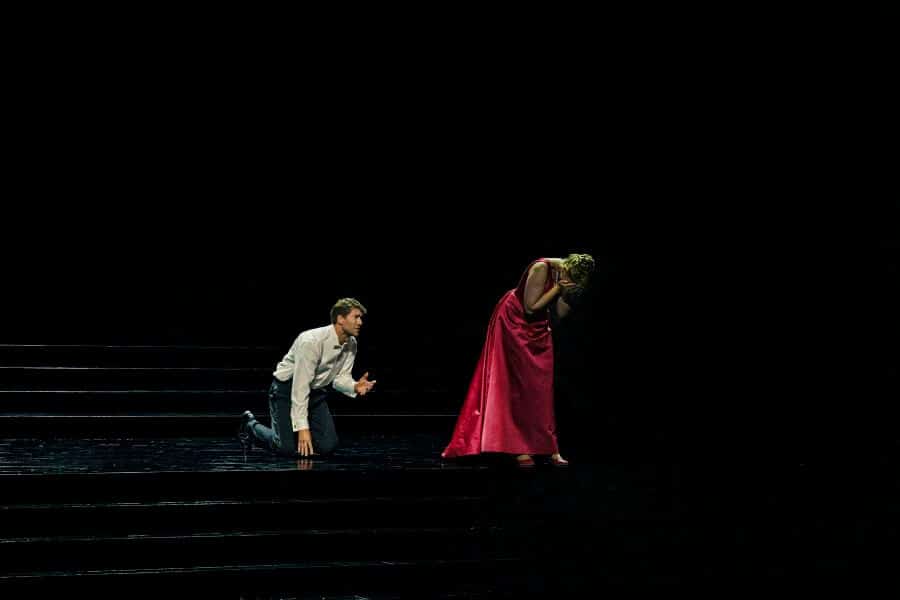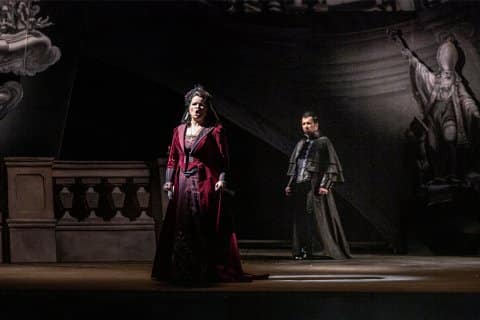EUGEN ONEGIN • COPENHAGEN OPERA
★★★★★☆

Photo: Henrik Stenberg
REVIEW EUGEN ONEGIN: 5 STARS AND 10 REASONS TO SEE IT
Tchaikovsky’s hit opera Eugene Onegin can now be experienced at the Copenhagen Opera in a first-class co-production with La Monnaie, one of Europe’s leading opera houses. Brilliant Danish soloists and a brilliant opera choir top this skillful staging, which there are at least 10 good reasons to rush in and experience. Let’s take them from the top!
1. Sofie Elkjær-Jensen hits a new career high as the village girl Tatjana. A soprano part that is considered one of the most challenging and requires both lyrical and dramatic talent. A task for the big names in the Anna Netrebko class, and one that Sofie Elkjær-Jensen accomplishes with bravura.
2. The famous letter aria in Act 1, where Tatyana expresses her love for Onegin in a heartfelt letter, is one of the highlights of the opera, and is poignantly delivered by the Danish soprano.
3. Tchaikovsky’s Onegin score from 1879 is a recognized masterpiece where I particularly enjoy the sequences of dark strings in beautiful, slender, melancholic melody lines. The leitmotifs weave deftly in and out, and sometimes it becomes almost Verdi-ish a la the opening ball scene in La Traviata, for example in the famous Polonaise in Act 3, which is opera at its most festive.
4. The Copenhagen opera chorus once again delivers a convincing, powerful performance in the beautiful choral movements, equipped with a suitably subdued mass choreography, cleaned of silly Russian local color and irrelevant bustle.
5. Onegin is played out in an exceptionally successful, minimalist set design in the form of a huge, rotating plateau that can be read as a playing field on which the actors of love make their moves. The staging delights as a homogeneous, aesthetic visual experience in a particularly beautiful lighting.
6. Jens Søndergård impresses in the title role as the spoiled aristocrat who rejects a young woman’s romantic invitation and realizes his mistake too late. The opera explores the power and powerlessness of love, and of course, it ends in fire for all involved. It’s all based on a verse novel by Pushkin, with a heavy undertone of deep Russian melancholy.
7. The costuming is simple but beautiful, with lots of dusty pastels, tuxedos, ball gowns and a ‘reborn’ Tatyana who closes the ball in a Tosca-red Duchess gown as the roles are reversed in the final scene and she rejects Onegin’s plea to undo the past and give love a second chance.
8. French conductor Marie Jacquot shapes the orchestra with fervor and delightful sound throughout the 3-hour running time, which, with its two intermissions, doesn’t feel a minute too long.
9. Jakob Skov Andersen delivers a fine tenor performance as his friend Lensky, who, trembling with fear, falls for Onegin’s well-placed shot in a foolish duel after a jealousy drama. His farewell aria to life reminded me of Cavaradossi’s Lucevan Le Stelle from Tosca and drew deserved applause.
10. The opera’s plot is admittedly a bit monotonous and not the most original, but the action is easy to follow. Sofie Elkjær-Jensen’s excellent interpretation of the iconic letter is well worth it. Onegin can be seen for that experience alone. Off you go.




